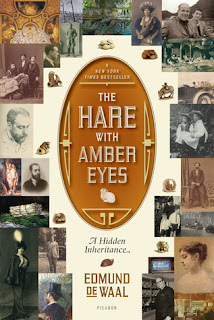The Hare With Amber Eyes
Summary (from the publisher): Edmund de Waal is a world-famous ceramicist. Having spent thirty years making beautiful pots --which are then sold, collected, and handed on--he has a particular sense of the secret lives of objects. When he inherited a collection of 264 tiny Japanese wood and ivory carvings, called netsuke, he wanted to know who had touched and held them, and how the collection had managed to survive.
And so begins this extraordinarily moving memoir and detective story as de Waal discovers both the story of the netsuke and of his family, the Ephrussis, over five generations. A nineteenth-century banking dynasty in Paris and Vienna, the Ephrussis were as rich and respected as the Rothchilds. Yet by the end of the World War II, when the netsuke were hidden from the Nazis in Vienna, this collection of very small carvings was all that remained of their vast empire.
Review: Part family history, part memoir, this work of non-fiction documents the author's travels and research to uncover the history behind the collection of 264 tiny Japanese wood and ivory carvings called netsuke that he inherited from a great-uncle. The netsuke take him back five generations to uncover the history of his ancestors, the Ephrussis, a nineteenth-century banking family that in its heyday was one of the wealthiest and most highly respected Jewish families in Paris and Vienna. Yet in the aftermath of WWII, all that remained of the vast Ephrussi fortune were the tiny Japanese carvings, whose size made it possible to save them when the rest of the family collections and property were seized by the Nazis.
The Ephrussi were able to amass huge art collections thanks to their wealth: "By 1860 the family had become the greatest grain-exporters in the world" (24). They were known as the Kings of Grain, with their own coat of arms and motto. The netsuke came into De Waal's family when a distant cousin, Charles Ephrussi, purchased them in Paris in the 1870s. Charles also collected over forty Impressionist works, paintings by "Morisot, Cassatt, Degas, Manet, Monet, Sisley, Pissarro, and Renoir" (74). Charles later gave the netsuke to the author's great-grandfather Viktor von Ephrussi as a wedding present, which is how the netsuke came to live in Vienna. Before WWI, Viktor's wealth was the equivalent of $400 million today. In the aftermath of World War II, with the family fortune gone and the family scattered, the author's great-uncle Ignace ultimately inherited the netsuke and took them with him when he moved, ironically, to Japan. The netsuke had come full circle.
At times I found the author's writing style distracting. The author inserts his own travels to notable places in his family's history in seemingly extraneous ways, such as telling his reader, "I drop my glasses and one of the arms fractures near the joint, so that I have to pinch them together to see anything at all" (112) and then using this to make an extended metaphor about being unable to see clearly. Additionally, he has a disconcerting habit of writing in the second person, as if striving to insert the reader into the scene as he sees it and to imagine the actions of his ancestors decades before: "But you can see its window, and imagine the tiered seating and a professor leaning over the lectern at the front. He is talking to you. Your hand moves in a dream across your notes" (184).
I found the Ephrussi family story moving and the small details that De Waal weaves into the narrative were heartbreaking at times. For instance, when Viktor finally is able to flee Vienna, he arrives in Prague with "the key to the bookcase in the library in the Palais, the bookcase of his early printed books of history" still on his watch-chain (268). But Viktor no longer legally owned the Palais or the bookcase or the books. And he would never see his home again. Additionally I liked the narrative frame of following the netsuke through history to tell their story, which is also to tell the story of the Ephrussi family and the author himself. This is a story of loss but also one of what survives and the Ephrussi family, while losing their home and wealth, were able to survive with their lives, which is a far better fate than many families faced.
Stars: 3



Comments
Post a Comment